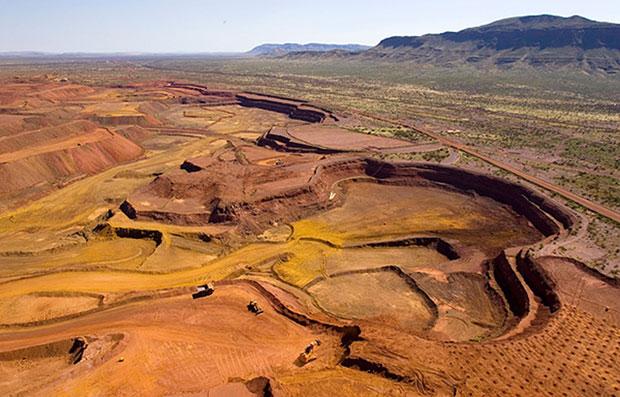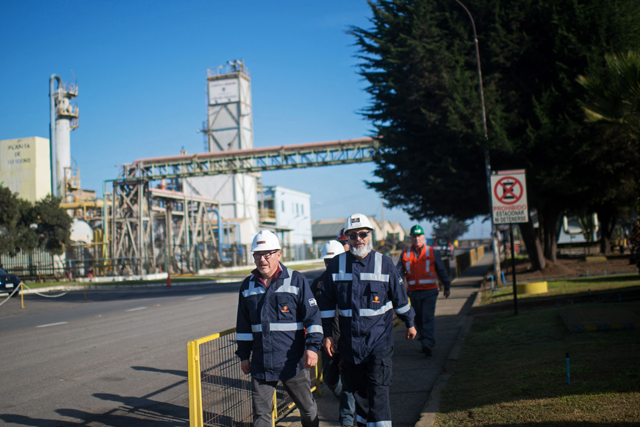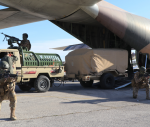You are here
Australia’s Pilbara targets tourists, farmers, and algae
By Reuters - Dec 08,2015 - Last updated at Dec 08,2015

Undated aerial view of the Marandoo open pit mine in Pilbara, Western Australia (Photo courtesy of Rio Tinto)
PORT HEDLAND Australia — Aqua farms growing super foods could soon materialise in the rust-red dust of the Australian outback, alongside wheat fields, haystacks and cattle herds, as tumbling iron prices drive the minerals-rich Pilbara region to transform itself.
On a small patch of desert 250km south of the Pilbara’s Port Hedland, InterClinical Laboratories has started Plankton Farms to propagate a type of micro-algae called Dunaliella salina, renowned for its antioxidant properties.
Work on the algae farms is in its infancy but the green micro-algae, which grows naturally in Australian salt lakes, could one day benefit nutrient-deficient people worldwide, according to InterClinical’s founder Ian Tracton.
“We were looking for a place with lots of sunny, cloudless, hot days and that’s what the Pilbara offers,” Tracton said.
“We’re the only flower in the area, surrounded by the resources industry just about everywhere you look.”
A further 200km inland, agronomists are conducting trials using water from mines to grow crops for use as biofuels and cattle feed, sometimes in partnership with the mining companies.
“The strong sentiment is let’s not be a mining town, but a town with a mine,” said Terry Hill, acting chief of the Pilbara Development Commission, which has A$1.7 billion ($1.25 billion) to help transform the Pilbara.
But the transformation will be slow and not generate the staggering economic prosperity seen during the mining boom years when steel mills paid upwards of $200 a tonne for iron ore. The price today is closer to $40.
The biggest obstacles are the environment and isolation. A part of the Pilbara holds the world record for a heatwave, recording 160 days in a row over 37.8oC in the summer of 1923-1924, according to the Australian Bureau of Meteorology.
Agriculture, aquaculture and tourism top the list of new industries, despite the harsh conditions and lack of even basic amenities outside the few towns peppering this northwestern corner of Australia, which is three times the size of England.
Industrial tourism
The number of tourists lining up to see the world’s longest trains dump iron ore into ships bound for China, or view rollercoaster-like mine conveyor belts and three-storey high truck tyres, is not large.
But promoters have tagged it “industrial vacationing” and hope it will put the Pilbara iron belt on the tourist map.
“We are encouraging all different types of visitors to come to the Pilbara for the experience,” said Jane Knapp, manager of the Karratha Visitors Centre, which offers behind-the-scenes looks at ship loadings and a view of a salt processing plant.
Karratha Visitors tour costs between A$19.95 and A$49.95 and numbers are up from last year.
Iron ore’s boom-to-bust trajectory is punching a big hole in the Australian economy, and no where more so than in the Pilbara. The 400,000 square kilometres expanse is the sixth-biggest economy in Australia and produces 90 per cent of the country’s iron ore exports — worth $40 billion last year.
This month construction finishes on Roy Hill, the last of the mines pocking the landscape with giant pits, at a cost of $10 billion and controlled by Gina Rinehart, one of the world’s wealthiest women.
“We won’t be seeing any more of these mega-projects coming out of the Pilbara for many years, if not decades,” said Gavin Wendt, an analyst for MineLife, a sector consultancy. “The market’s just not there anymore.”
Asian dining boom
Rinehart and others who made billions selling iron ore to Asia are now scooping up land alongside their mines to farm and raise livestock as an Asian “dining boom” unfolds. Mardie Station, south of Karratha, is owned by Chinese mining company Citic Pacific and runs a herd over a half-million acres.
“We are determined to ensure that the Australian agricultural industry’s future in China is as bright as our mining future,” said Andrew Forrest, founder of Fortescue Metals, the Pilbara’s biggest mining rights holder.
Forrest’s pastoral land holdings in Western Australia state exceed 1 million acres. In 2014, he acquired Harvey Beef, which employs 400 people and processes more than 130,000 head of Pilbara cattle a year.
Rio Tinto already irrigates 85,000 acres to grow hay using water from a mine. The company also runs 25,000 head of cattle on Pilbara land.
Pilbara politician Brendan Grylls sees the end of the mining boom, which fuelled sky high wages and home prices and caused an exodus of residents, as a chance to repopulate towns and establish new permanent communities in the isolated region.
Related Articles
High-cost Australian miners are battling for survival as plunging iron ore prices push many to breaking point, with analysts seeing no significant short-term recovery as Chinese demand for steel wanes in line with sliding property prices.
SYDNEY — Mining giant BHP reported an 86 per cent slump in half-year net profit on Tuesday, hit by a writedown of its nickel assets and cost
SYDNEY — Global mining giant BHP said Thursday it had been underpaying thousands of Australian staff for more than a decade, an error that w
















